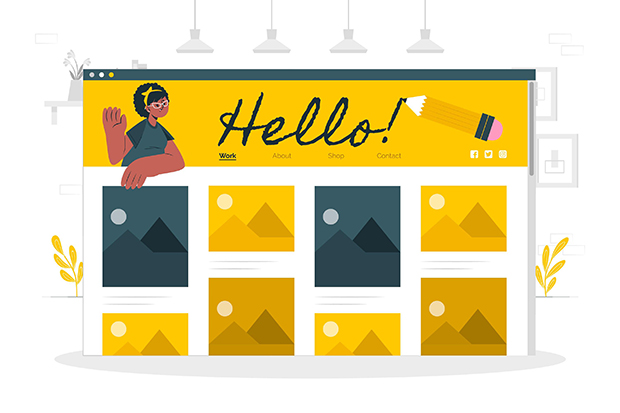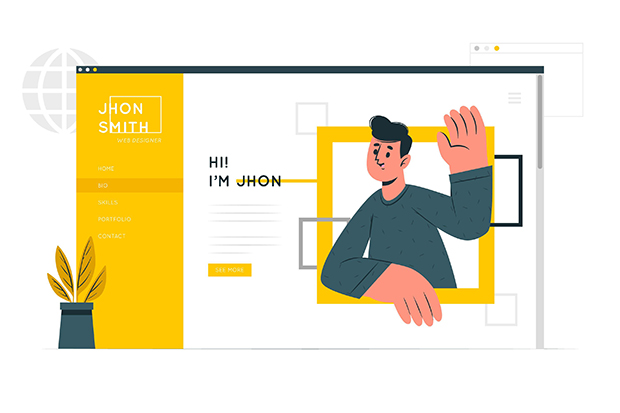How to Build Your Front End Designer Portfolio

Your portfolio is what will help you get your foot in the door as a front-end designer. It's what will help you get your job interviews, and it's also how you'll demonstrate that you're the front-end designer they need on their team.
Take some time to create something that represents who you are as a front-end designer. Something that looks good shows off your work, and demonstrates just how much you know. With that in mind, below are some tips on how to build your front-end designer portfolio with a portfolio WordPress theme.
Custom Logo
It can be hard to stand out from the crowd as a front-end developer. You might feel shy about your work. Everyone has an opinion on design, so you may think that what you've done is subpar. Whatever the reason is, if you want great feedback for your designs, having a great logo will help tremendously.
People will be more likely to go onto your website when you have a great logo. Instead of wondering who the creator is, they'll know who it is at first glance. That's why having an awesome logo is important for any portfolio.
Have a Downloadable Resume
This article is written for all of the designers out there looking to show off their work. Whether you are just starting out or have been in the industry for years, your resume is an invaluable tool that should be given special attention. There are plenty of portfolios online which display design work via screenshots and images, but what about when someone wants to take that work home with them? Your resume is the perfect place to showcase your best work, along with what you can provide.
When you're building a portfolio, it's important to consider an appropriate balance of information for different mediums. The most common type of medium is either PDF or HTML/CSS. Other options are also available but are less widely used.
Create an About Page With Bio
A fundamental part of your portfolio is an about page with a bio. It is a chance to tell the story of who you are and how your experiences have shaped your passions. Your bio should be short and succinct, focusing on your career path. You can also provide some context for the type of projects you have worked on, what you are interested in, what language(s) you know how to code with, etc.
Your bio page should always be linked to your main portfolio page, so it's easily accessible to the reader. Often, this is also a chance for you to call out any accolades or notable projects that your viewers might have missed otherwise in a more detailed list format. If you are unsure what to include in this section, take a look at the about pages of other designers to get ideas.
When writing your bio page, avoid using industry jargon or acronyms that aren't explained immediately. You should be able to read through this section and understand who you are as a designer without having to do any additional research.
Make Sure There is a Photo of You

Not only will you automatically look more professional, but your photo will remind your employer (or potential employer) of who they are doing business with. People like to work with people, not with faceless entities. It is especially important if you are applying through an agency rather than directly to a company.
Do not include too casual photos; it is better to be overdressed than underdressed. You may also want to avoid unusual clothing or accessories, so you don't stand out for the wrong reasons.
Have Easy to Find Contact Info
A common mistake that you'll see with young designers is that they don't display any contact information in their portfolios. With the proliferation of portfolios online, it's becoming more important to have a high level of professionalism. If someone wants to hire you for a project, how would they get in touch with you? It's as simple as that.
Contact information should be front and center. Display your email address (make sure it's not filled with spambots), phone number, Facebook page, Github profile - whatever you wish to share. If it isn't easy enough for someone to contact you, then they might assume that your portfolio isn't high-priority to you either.
Include Your Socials
Make sure your portfolio contains links to all of your social media profiles. Why?
Because it can save your employer a lot of trouble later down the road and provides links to places where you likely already have work is shown and reactions from your followers and friends, it also shows that you're up-to-date with technology and social media trends.
Be aware that most employers will not hire you based on what they find on your social media profiles. What is important is your skillset and contributing to their company. However, if a potential employer finds something inappropriate on your profile, it might hurt their opinion of you as an employee for this company. All in all, having social profiles that stand out is incredibly important.
Specializations
It is important to include a list of all of your specialties and services in your portfolio so people know what you have the most experience with. It can be hard to know what specialties and services to feature in your portfolio when you're a front-end designer. It's okay if you don't have a lot of experience with all the different types of front-end design projects - that's why it's important to list the ones you are familiar with.
Listing each design specialty and service you provide will give potential employers a better idea of what your past work entails.
Conclusion
It is important to make sure your portfolio screams professionalism and seriousness about your craft. The ability to prove yourself as a designer is the most valuable attribute you can have going into a job interview.
If you're looking for a job as a front-end web developer, it's increasingly important that you have a solid portfolio to base your work.
Copyright © . All Rights Reserved